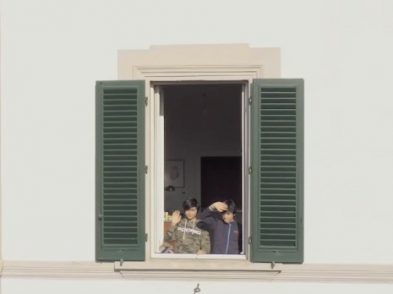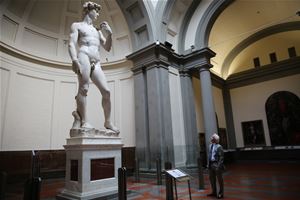Preliminary work on the high-speed TAV lines started in Florence this month. While the railway system promises to ease intercity travel, shorten journey times to France, and lessen road traffic, there is much fear among residents in Florence’s northern neighbourhoods about the impact that the underground drilling may have on their homes and the city, in general. TF’s Kirsten Hills looks at the fine balance between progress and residents’ concerns.
Just weeks ago, retired professor Maria Rosa Giordani had a device fitted to her seventh-floor apartment on viale Corsica to measure any movement from the underground drilling, due to start soon.
‘Of course I am concerned about my home, but that’s not the most important issue here,’ she explains. ‘People think it will improve Florence, make it more modern. It’s just not true. I am extremely worried about the impact on the beautiful city and concerned about the level of ignorance about the TAV.’
Her apartment overlooks the route of the high-speed train line, close to the Fortezzo da Basso. Preliminary work on two 7 km long tunnels under the city, connecting Campo di Marte to the Castello area, has started. This is where the new station designed by Norman Foster, is planned (see http://bit.ly/t4B4Py for a map of the construction route).
In the next few weeks, drilling on the tunnels will begin. The depth of the tunnels under Florence will vary between 16 and 40 metres. It’s expected to take four years to complete the drilling and another year to build the supports and electrical system; the drilling machine is expected to clear between 16 to 18 meters a day.
Since 2009, two railway tracks in the city have been used by the high speed service between Florence, Milan and Naples. The two tunnels under the city (one in each direction) will be exclusively used by TAV, freeing up the other tracks for local train services. It will speed up journey time by around ten minutes, as trains in and out of Florence’s busy Santa Maria Novella can’t go at full-speed capacity.
Many residents here have serious concerns about the structural and environmental impact of the TAV project. They are very aware of what has happened in Bologna and the Mugello, where TAV construction has resulted in structural and environmental damage and costly legal claims for compensation to locals. Behind the TAV is the Ferrovie dello Stato, the Italian state railway company, which has classified 277 buildings in Florence as ‘potentially at risk’ of damage. Already, 180 families in Florence are taking joint legalaction, represented by solicitor Alfonso Bonafede. Their case is challenging the TAV on the grounds of the risk of damage to their health and homes. Bonafede believes it’s not too late if ‘the public’s concerns are listened to properly.’
‘When the machines passes under us, I certainly won’t be at home,’ smiles Carlo Biancalani. His apartment on viale Don Giovanni Minzoni, in Campo di Marte, has seen many changes, which he believes were caused by the TAV’s construction.
He once had a view of a flourishing wild garden from his window, but the laurel trees have now been cleared for parking, which he claims is being used by builders working on the nearby TAV site. ‘We need more green space here in Florence, not less. It makes this area all the more difficult for families to live-they are being pushed out.’
Many people oppose the TAV project on the grounds of its cost (estimates vary between 800 million to 3 billion euro). ‘At a time of financial crisis, the cost is even harder to justify,’ says Biancalani. ‘I think those who made the decision to build TAV had a financial interest in it going ahead, so the alternatives have not been considered carefully enough.’
Academics from University of Florence have drawn up an alternative system, using pre-existing rail tracks (see http://www.lapei.it/?page_id=975). Their project, which doesn’t require any underground drilling, promises to be cheaper and faster to bring to fruition, and less risky to buildings. It has the full support of Piero Baronti, president of the Tuscan chapter of the national environmental group Legambiente. The group isn’t against the TAV, but is concerned about the financial impact on local transport. ‘Berlusconi has already outlined transport cuts of 60 percent, which we still haven’t felt. This along with the massive investment in TAV will mean no more money for local services.’
The TAV line also has its supporters in the city. Florence-based shoe-production manager Roberto Cecchi believes investment in the TAV will have a positive impact on Florence and Italy. He often travels to northern Italy for work. He says the route to Bologna by car is long and dangerous and believes the TAV will make a massive difference to his working life. He says in the long term there will be less road traffic, ‘which can only be a good thing. Environmentally, it makes sense.’
The project, which has been partly funded by European Union, has created thousands of jobs at a time of high unemployment. For this reason, it also has the support of some trade unions. It will not only speed up travel, but make it safer too, because it will upgrade the signalling system. It promises to dramatically cut volumes of freight lorries, enabling the transportation of goods by rail, rather than by road. It will also offer a viable alternative to air travel to northern Italy and France.
Although work on the TAV is well underway, the objection to it isn’t easing. In the Susa Valley, near Turin, feelings are running as high as ever. The area is of strategic importance, because it is the link between Milan and Paris. Once complete, the TAV promises to cut journey times between the two cities by three hours. A number of demonstrations there have turned violent in the past. Most recently, on October 23, thousands of people concerned about its environmental impact protested peacefully. A week later, more activists protested by ‘fence cutting’ at the construction site.
Back in Florence, there is a begrudging acceptance among residents that the TAV project will go ahead. But the NO TAV campaign continues its fight. On October 29, opponents of the TAV demonstrated outside the Stazione Leopolda, during the Big Bang event, organised by Florence’s mayor Matteo Renzi. The same weekend, the NO TAV Tour arrived in the city to promote its campaign, and above all encourage a last-minute political re-think.
But for Maria Rosa Giordani, it’s not enough. She sighs, ‘It is a done deal, and too late to stop it. Our only hope now is that the project runs out of money; it’s the only way it will stop going ahead.’
Kirsten Hills tried contacting for an interview Ferrovie dello Stato, which re-directed her to the website, and the architects of the new station, Norman Foster and Partner, who said they had nothing to add to the issue.







